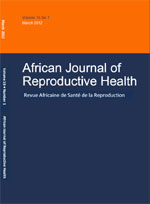
|
African Journal of Reproductive Health
Women's Health and Action Research Centre
ISSN: 1118-4841
Vol. 17, No. 3, 2013, pp. 110-118
|
 Bioline Code: rh13044
Bioline Code: rh13044
Full paper language: English
Document type: Research Article
Document available free of charge
|
|
|
African Journal of Reproductive Health, Vol. 17, No. 3, 2013, pp. 110-118
| en |
Maternal Risk Factors for Childhood Anaemia in Ethiopia
Habte, Dereje; Asrat, Kalid; Magafu, Mgaywa; Ali, Ibrahim; Benti, Tadele; Abtew, Wubeshet; Tegegne, Girma; Abera, Dereje & Shiferaw, Solomon
Abstract
A total of 8260 children between the ages of 6-59 months were analyzed to identify the risk factors associated with childhood anaemia in Ethiopia. The overall mean (SD/ standard deviation) haemoglobin (Hgb) level among the under-five children was 10.7 (2.2) g/dl and 50.3% were anaemic. Childhood anaemia demonstrated an increasing trend with maternal anaemia levels of mild, moderate and severe anaemia: odds ratio of 1.82, 2.16 and 3.73 respectively (p< 0.01). Children whose mothers had no formal education were 1.38 times more likely to be anaemic (p<0.01). The poorest and poorer wealth index groups had 1.52 and 1.25 increased odds of childhood anaemia respectively (p< 0.01). Childhood anaemia in Ethiopia is a severe public health problem. Maternal anaemia and socio-economic status were found to be associated with anaemia in children. A holistic approach of addressing mothers and children is of paramount importance.
Keywords
Maternal; anaemia; child; risk factor; Ethiopia
|
| |
| fr |
Habte, Dereje; Asrat, Kalid; Magafu, Mgaywa; Ali, Ibrahim; Benti, Tadele; Abtew, Wubeshet; Tegegne, Girma; Abera, Dereje & Shiferaw, Solomon
Résumé
Un total de 8260 enfants âgés de 6-59 mois ont été analysés afin d'identifier les facteurs de risque associés à l'anémie de l'enfance en Ethiopie. La moyenne (type SD / écart standard) hémoglobine niveau global (Hgb) chez les enfants qui ont moins de cinq ans était de 10,7 (2,2) g / dl et 50,3% étaient anémiques. L’anémie de l'enfance a démontré une tendance à la hausse des niveaux d'anémie maternelle de l'anémie légère, modérée et sévère: odds ratio de 1,82, 2,16 et 3,73 respectivement (p <0,01). Les enfants dont les mères n'avaient pas été scolarisées étaient 1,38 fois plus susceptibles d'être anémiques (p <0,01). Les groupes de l'indice de richesse les plus pauvres et les moins pauvres avaient 1,52 et 1,25 probabilité accrue d'anémie infantile, respectivement (p <0,01). L’anémie chez les enfants en Éthiopie est un problème de santé publique grave. L’on a découvert que l'anémie maternelle et la situation socio-économique ont été associées à l'anémie chez les enfants. Une approche holistique pour s’occuper des mères et des enfants est d'une importance primordiale.
Mots Clés
Maternal; anaemia; child; risk factor; Ethiopia
|
| |
© African Journal of Reproductive Health
Alternative site location: http://www.ajrh.info
|
|
